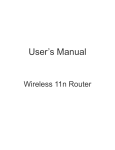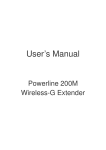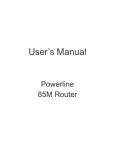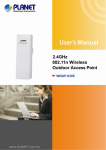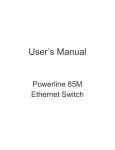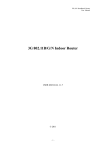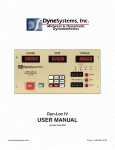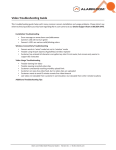Download User`s Manual
Transcript
User’s Manual Powerline 200M Wireless-N Extender Index FCC Part 68..............................................................................................................................................................3 FCC Part 15..............................................................................................................................................................4 Chapter 1 Introduction ..............................................................................................................................................5 1.1 Overview ...........................................................................................................................................5 1.2 Features ............................................................................................................................................5 1.3 System Requirements .......................................................................................................................6 Chapter 2 Installation................................................................................................................................................7 2.1 Checklist............................................................................................................................................7 2.2 The Front LEDs .................................................................................................................................8 2.3 The Rear Ports ..................................................................................................................................8 2.4 The Bottom Port ................................................................................................................................9 Chapter 3 Configuration......................................................................................................................................... 10 3.1 Determine your connection settings............................................................................................... 10 3.2 Connecting the Powerline Extender to your network ..................................................................... 10 3.3 Configuring with Web Browser....................................................................................................... 10 3.3.1 Management IP ............................................................................................................................11 3.4.1 Wireless Basic Settings............................................................................................................... 12 3.4.2 Wireless Advance Settings.......................................................................................................... 13 3.4.3 Wireless Security......................................................................................................................... 15 3.4.4 Wireless MAC ACL...................................................................................................................... 18 3.4.5 Wireless WPS Settings ............................................................................................................... 19 3.5.1 System Information ..................................................................................................................... 21 3.5.2 Packet Statistics .......................................................................................................................... 22 3.5.3 System Log ................................................................................................................................. 23 3.6.1 Admin Account............................................................................................................................. 24 3.6.2 System Log Settings ................................................................................................................... 25 3.6.3 Config .......................................................................................................................................... 26 3.6.4 Firmware Update......................................................................................................................... 27 3.7.1 Logout ......................................................................................................................................... 28 3.7.2 Reboot......................................................................................................................................... 29 3.7.3 TCP/IP Settings for Windows Operating System ........................................................................ 30 Chapter 4. Powerline Networking Utility ................................................................................................................ 37 4.1 Configuration Utility Setup.............................................................................................................. 37 4.1.1 Installation of the Utility ............................................................................................................... 37 4.2 Windows Configuration Utility ........................................................................................................ 38 4.3 User Interface................................................................................................................................. 39 1 4.3.1 Main Screen ................................................................................................................................ 39 4.3.2 Privacy Screen ............................................................................................................................ 43 4.4 Diagnostics Screen ........................................................................................................................ 45 4.4.1 About Screen............................................................................................................................... 47 4.4.2 Preferences ................................................................................................................................. 47 4.5 Troubleshooting.............................................................................................................................. 48 4.5.1 When the remote Powerline devices can not connect or access? ............................................. 48 Appendix A Glossary.............................................................................................................................................. 50 Appendix B Cabling / Connection.......................................................................................................................... 57 2 FCC Part 68 This equipment complies with Part 68 of the FCC Rules. On the bottom of this equipment is a label that contains the FCC Registration Number and Ringer Equivalence Number (REN) for this equipment. You must provide this information to the telephone company upon request. The REN is useful to determine the quantity of devices you may connect to the telephone line and still have those entire devices ring when your number is called. In most, but not all areas, the sum of the REN of all devices connected to one line should not exceed five (5.0). To be certain of the number of devices you may connect to your line, as determined by the REN, you should contact your local telephone company to determine the maximum REN for your calling area. If the modem causes harm to the telephone network, the telephone company may discontinue your service temporarily. If possible, they will notify you in advance. But if advance notice isn't practical, you will be notified as soon as possible. You will be advised of your right to file a complaint with the FCC. The telephone company may make changes in its facilities, equipment, operations, or procedures that could affect the proper operation of your equipment. If they do, you will be notified in advance to give you an opportunity to maintain uninterrupted telephone service. If you experience trouble with this modem, please contact your dealer for repair/warranty information. The telephone company may ask you to disconnect this equipment from the network until the problem has been corrected or you are sure that the equipment is not malfunctioning. This equipment may not be used on coin service provided by the telephone company. Connection to party lines is subject to state tariffs. 3 FCC Part 15 The modem generates and uses radio frequency energy. If it is not installed and used properly in strict accordance with the user's manual, it may cause interference with radio and television reception. The modem has been tested and found to comply with the limits for Class B computing devices in accordance with the specifications in Subpart B, Part 15 of the FCC regulations. These specifications are designed to provide reasonable protection against such interference in a residential installation. However, there is no guarantee that interference will not occur in a particular installation. FCC regulations require that shielded interface cables be used with your modem. If interference does occur, we suggest the following measures be taken to rectify the problem: 1) Move the receiving antenna. 2) Move the modem away from the radio or TV. 3) Plug the modem into a different electrical outlet. 4) Discuss the problem with a qualified radio / TV technician. CAUTION: Changes or modifications not expressly approved by the party responsible for compliance to the FCC Rules could void the user's authority to operate this equipment. Cable connections: All equipment connected to this modem must use shielded cable as the interconnection means. Notes: Operation is subject to the following two conditions: 1) This device may not cause harmful interference, and 2) This device must accept any interference received including interference that may cause undesired operation. 4 Chapter 1 Introduction Congratulations on your purchase of an Instant Powerline 200M 11n Extender. The Powerline Extender is the perfect option to connect a small group of PCs or small wireless clients. Integrated Wireless to Powerline networks, the device can extend large coverage and less dead space for your home network. 1.1 Overview Integrated with 3 10/100M ports, it will very easy to use as a switch, and combine the wireless and Powerline function inside. Using Powerline and wireless benefit, you can connect the pc to internet in anywhere of your home.. 1.2 Features z Internet Access ‧TCP/IP, UDP, ICMP, ARP, RARP, Static IP assignment z Standard ‧IEEE 802.3, 802.3u Ethernet standards ‧HomePlug AV ‧IEEE 802.11b/g and 11n Wireless standards z QoS ‧Prioritized random access, contention-free access and segment bursting ‧Eight levels of prioritized random access, contention-free access, and segment bursting z z Powerline Modulation ‧OFDM (Orthogonal Frequency Division Multiplexing) with patented signal processing techniques for high data reliability in noisy media conditions ‧Supports QAM 256/64/16, DQPSK, DBPSK and ROBO modulation schemes z Security ‧Provide 128-bit AES link encryption for Powerline network z Wireless Features ‧Support 802.11b/g and n Wireless Access Point, WDS and AP Client ‧Support 128-Bit and 64-Bit WEP encryption , 802.1x, WPA, WPA2 and WPS z Other ‧High-Speed Powerline adapter with Ethernet interface for fast data transfer over the existing household power supply ‧The high-speed transfer rates of 200Mbps even make it possible to transmit video in DVD quality ‧No need new wires and use at any power socket with up to ranges of 200 meters 5 z HTTP Web-Based Management ‧Firmware upgrade by UI ‧Password protected access 1.3 System Requirements 1) Personal computer (PC) 2) Pentium II 233 MHz processor minimum 3) 32 MB RAM minimum 4) 20 MB of free disk space minimum 5) Ethernet Network Interface Controller (NIC) RJ45 Port 6) Internet Browser 6 Chapter 2 Installation This chapter offers information about installing your router. If you are not familiar with the hardware or software parameters presented here, please consult your service provider for the values needed. 2.1 Checklist Check the shipping box carefully to ensure that the contents include the items you ordered. If any of the items are missing or damaged, contact your local distributor. The contents of your carton may vary depending on your service provider. Contents description 1) Powerline 200M Wireless-N Extender for home/office use 2) Powerline 200M Wireless-N Extender Installation and Operation Guide (this publication) 3) Power Cord 4) Ethernet cable Ethernet category 5 twisted pair cable (6 ft) Application for this device 7 2.2 The Front LEDs LED State POWER ON Description Press the button to power one the router. OP Flashing The router running well. PL Flashing When the device detect other Powerline devices ON Link Flashing TX or RX activity No Link LAN OFF LAN (Local Area Network) port is where you will connect networked device, such as PC, print server remote hard drive, and anything else you want to put on your network. ON WLAN Wireless On Flashing Data transfer between AP and wireless clients OFF No link. 2.3 The Rear Ports Connector POWER LAN Secure Antenna Description Connect to power cord. Router is successfully connected to a device through the corresponding port. If the LED is flashing, the Router is actively sending or receiving data over that port. Button can auto secure and group the Powerline devices. There are three antennas, fixed or R/SMA connecter. 8 2.4 The Bottom Port Connector Reset Switch Description 1. Press 2 sec to enable the WPS function. 2. Press 10 sec to reboot the router and restore default settings. 9 Chapter 3 Configuration 3.1 Determine your connection settings Before you configure the router; you need to know the connection information supplied by your service provider. 3.2 Connecting the Powerline Extender to your network Unlike a simple hub or switch, the setup of the Powerline Extender consists of more than simply plugging everything together. 3.3 Configuring with Web Browser It is advisable to change the administrator password to safeguard the security of your network. To configure the router, open your browser, type 'http://192.168.16.168' into the address bar and click 'Go' to get to the login page. Save this address in your Favorites for future reference. At the Password prompt, the User name is 'admin' and the password is ’admin’. You can change these later if you wish. Click 'OK' to login. 10 3.3.1 Management IP You can set IP address at this page. 11 3.4.1 Wireless Basic Settings WLAN User can enable or disable the wireless function. Wireless Mode Support 802.11b/g/n Mixed, 802.11b/g Mixed, 802.11b, 802.11g, and 802.11n modes. WLAN Frequency The channel number is used for wireless network. The channel setting of the wireless devices within a network should be the same. WLAN SSID The identifier set for the wireless network. You can change the SSID. Only devices with the same SSID can interconnect. WLAN MAC You can change the MAC address in this column. 12 3.4.2 Wireless Advance Settings Hide SSID: Hide SSID to secure your network. Default is disable. Beacon Period: Choosing beacon period for improved response time for wireless http clients. DTIM Period: The DTIM period indicated how many beacon frames can transmit before another DTIM is transmitted. RTS Threshold: RTS stands for “Request to Send”. This parameter controls what size data packet the low level RF protocol issues to an RTS packet. Default is 2347. Fragment Threshold: When transmitting a packet over a network medium, sometimes the packet is broken into several segments, if the size of packet exceeds that allowed by the network medium. The Fragmentation Threshold defines the number of bytes used for the fragmentation boundary for directed messages. Tx Power: TX Power measurement. Default is 100%. b/g Protection: A protection mechanism prevents collisions among 802.11b/g nodes. Overlapping Legacy BSS: It’s an option to enable/disable Overlapping Legacy BSS Condition Protection(OLBC) Short Slot: When short slot is enabled, the wireless device uses the short slot time only when all clients associated to the 802.11g, 2.4GHz radio supports short slot time. Short slot time is an 802.11g only feature and does not apply to 802.11a radios. Tx Burst: Enable the transmitted time slot can increase transmission throughput. Tx Short Preamble: Specify the Preamble type is short preamble or long preamble. 13 Packet Aggregation: The parameter can be used to increase the delivered bandwidth in community networks including fixed and mobile stations. WMM Support: Enable/disable the WMM support. 802.11h Support: Enable/disable the 802.11h support. Channel Switch Period: If you enable 802.11h Support, specify the channel in beacon value. HT Operation Mode: Mixed mode operation: In this mode, both the MIMO-OFDM systems and the legacy systems shall co-exist. The MIMO system should have the capability to generate legacy packets for the legacy systems and high throughput packets for MIMO-OFDM systems. So, the burst structure should be decodable to legacy systems and should provide better performance to MIMO-systems. Green field mode operation: This mode is similar to mixed mode where the transmission happens only between the MIMO-OFDM systems in the presence of legacy receivers. However, the MIMO-OFDM packets transmitted in this mode will have only MIMO specific preambles and no legacy format preambles are present. HT Channel Bandwidth: Specify the channel bandwidth. HT Guard Interval: Guard-interval is used to reduce interference of multi-path channel. Specify the guard interval is 400 ns or 800 ns to increase throughput. HT TX Aggregate MSDU: This option allows aggregation of multiple MSDUs in one MPDU. 14 3.4.3 Wireless Security This function allows you setup the wireless security. Turn on WEP or WPA by selecting Authentication mode could prevent any unauthorized access to your wireless network. WEP WEP aims to provide security by encrypting data over radio waves so that it is protected as it is transmitted from one end point to another. However, it has been found that WEP is not as secure as once believed. Select Authentication Mode as Open, Shared, or WEP Auto; and then Specify Encryption. Type as “WEP” can prompt the setting page. Default Key ID: Specify which key is used for encryption. Key1 to Key4: Enter the key value depending on selected ASCII or Hexadecimal. WPA/WPA2 Wi-Fi Protected Access(WPA and WPA2) is a class of systems to secure wireless computer networks. WPA is designed to work with all wireless network interface cards, but not necessarily with first generation wireless access points. WPA2 implements the full standard, but will not work with some older network cards. Both provide good security, with two significant issues: Ether WPA or WPA2 must be enabled and chosen in preference to WEP. WEP is usually presented as the first security choice in most installation instructions. In the “Personal” mode, the most likely choice for homes and small offices, a pass phrase is required that, for full 15 security, must be longer than the typical 6 to 8 character passwords users are taught employ. WPA2 Personal Encryption Type: Select the encryption type (TKIP or AES) for data encryption. WPA/WPA2 Pre-Shared Key: Pre-shared key mode (PSK, alos known as personal mode) is designed for home and small office networks that cannot afford the cost and complexity of an 802.1x authentication server. Each user must enter a pass phrase to access the network. It can be a password like “jeanY-13i”, a pass phrase like “Idaho hung gear id gene”, or a hexadecimal string like “65E4 E556 8622 EEE1”. A pre shared key is a password which is entered to access a secure WiFi system sing WEP or WPA. Both the wireless access point (AP) and the client share the same key. WPA ReKey Method: Specify the ReKey method (by Time or by Packet). Default is disable. WPA PeKey Interval: If you enable WPA ReKey method, then specify the interval. Pairwise Master Key Cache Interval: In the Fast Roaming section, you can configure Pairwise Master Key (PMK) caching and pre-authentication options. PMK Cache Interval: The number of minutes before deletion (and renewal) of the Pairwise Master Key used for authentication. Pre-Authentication Support: According to some of the preferred embodiments, a method for proactively establishing a security association between a mobile node in a visiting network and an authentication agent in another network to which the mobile node can move includes: negotiating pre-authentication using a flag in a message header that indicates security association; and one of the mobile node and the authentication agent initiating pre-authentication by transmitting a message with the flag set in its message header, and the other of the mobile node and the authentication agent responding with the flags set in its message header only if it supports the pre-authentication. Enable/disable pre-authentication support. Default is disable. WPA/WPA2 Enterprise Encryption Type: Select the encryption type (TKIP or AES) for data encryption. WPA ReKey Method: Specify the ReKey method (by Time or by Packet). Default is disable. WPA PeKey Interval: If you enable WPA ReKey method, then specify the interval. Pairwise Master Key Cache Interval: In the Fast Roaming section, you can configure Pairwise Master Key (PMK) caching and pre-authentication options. PMK Cache Interval: The number of minutes before deletion (and renewal) of the Pairwise Master Key used for authentication. Pre-Authentication Support: According to some of the preferred embodiments, a method for proactively establishing a security association between a mobile node in a visiting network and an authentication agent in another network to which the mobile node can move includes: negotiating pre-authentication using a flag in a message header that indicates security association; and one of the mobile node and the authentication agent initiating pre-authentication by transmitting a message with the flag set in its message header, and the other of the mobile node and the authentication agent responding with the flags set in its message header only if it supports the pre-authentication. Enable/disable pre-authentication support. Default is disable. Radius Server Network: The communication between the RADIUS client and the RADIUS server are 16 authenticated and encrypted through the use of a shared secret, which is not transmitted over the network. Select the network is WAN or LAN. Radius Server Address: Enter IP address of radius server. Radius Server Port: Enter port number of radius server. Default is 1812. Radius Server Key: Enter a string for certificating. WDS Setting WDS: Restricted – WDS peers must be registered with AP router (by MAC addresses) Bridge – AP router will function as a wireless bridge, merely forwarding traffic between access points, and will not respond to wireless requests. The WDS peers must be manually stated and wireless stations will not be able to connect to AP router. Repeater – AP router will act as a repeater, interconnecting between access points. WDS peers can be determined by the user (Restricted mode) or auto-detected (Lazy mode) WDS Encryption Type: Lazy – Automatic detection of WDS peers. When a LAN user searches for a network, AP router will attempt to connect to WDS devices in its vicinity. When the Authentication Mode is set as Open, Shared, or WEP auto; WEP is the only WDS encryption type. When the Authentication Mode is set as WPA Personal or WPA2 Personal, the WDS encryption type can be TKIP or AES. WDS WPA/WPA2 Pre-Shared Key: Specify the pre-shared key to secure WDS, if your authentication mode is set as WPA Personal or WPA2 Personal. WDS MAC List: Specify the destination MAC address device. The MAC address filter tunneling lets you select exactly which stations should have access to your network. Note: When WDS is enabled, the WPA/WPA2 enterprise support will be unavailable. AP Client The AP client feature allows the AP to effectively become a wireless client of remote AP. When the AP client is enabled, both the wired and wireless clients can access the remote AP through this AP client. Note: 1. When AP Client is enabled, the WPA/WPA2 enterprise support will be unavailable. 2. Please ensure the channel of the AP is the same as the remote AP which this AP client will connect to. 17 3.4.4 Wireless MAC ACL For Security reason, using MAC ACL’s creates another level of difficulty to hacking a network. A MAC ACL is created and distributed to AP so that only authorized NIC’s can connect to the network. While MAC address spoofing is a proven means to hacking a network this can be used in conjunction with additional security measures to increase the level of complexity of the network security decreasing the chance of a breach. MAC address can be add/delete/edit from the ACL list depending on the MAC Access Policy. 18 3.4.5 Wireless WPS Settings User can enable WPS function in this page. WPS (Wi-Fi Protected Setup) is a new Wi-Fi Security. There are 2 ways to set the WPS, Pushbutton or PIN Code. Press the Reset button for 2 seconds, the WPS function will auto enable. Or you can enable the WPS in this page to fill out the PIN Code, the router cab be the Registrar or Enrollee. For make sure the WPS work property, all the devices need to support this function. This section presents a high-level description of the Simple Config architecture. Much of the material is taken directly from the Simple Config specification. Figure 1 depicts the major components and their interfaces as defined by Wi-Fi Simple Config Spec. There are three logical components involved: the Registrar, the access point (AP), and the Enrollee. The Enrollee is a device seeking to join a WLAN domain. Once an Enrollee obtains a valid credential, it becomes a member. A Registrar is an entity with the authority to issue and revoke domain credentials. A registrar can be integrated into an AP. The AP can be either a WLAN AP or a wireless router. 19 Registration initiation is ordinarily accomplished by a user action such as powering up the Enrollee and optionally, running a setup wizard on the Registrar (PC). 20 3.5.1 System Information This page displays the current information for the device. It will display the LAN, WAN, and system firmware information. This page will display different information for you, according your WAN setting (Static IP, DHCP, or PPPoE). If your WAN connection is set up for Dynamic IP address, there will be a Release button and Renew button. Use Release to disconnect from your ISP and use Renew to connect to your ISP. If your WAN connection is set up for PPPoE, there will be a Connect button and Disconnect button. Use "Disconnect" to drop the PPPoE connection and use "Connect" to establish the PPPoE connection. 21 3.5.2 Packet Statistics The device keeps statistic of the data traffic that it handles. You are able to view the amount of Receive and Sent packets that passes through the device on both the WAN port and the LAN ports. The traffic counter will reset when the device is rebooted. 22 3.5.3 System Log The log file keeps a running log of events and activities occurring on the device. The log always displays recent logs. When the device is rebooted, the logs would not be cleared. 23 3.6.1 Admin Account The administrator account can access the management interface through the web browser. Only the administrator account has the ability to change account password. Administrator Name: Assign a name to represent the administrator account. Maximum 16 characters. Legal characters can be the upper letter “A" to “Z", lower letter “a" to “z", digit number “0" to “9" and an underscore sign"_". The administrator name is case-sensitive. Note: the “blank” character is an illegal character Administrator Password: Assign the administrator password, the Maximum 16 characters and minimum 6 characters. Mix the characters with the digits. Legal characters can be the upper letter “A" to “Z", lower letter “a" to “z", digit number “0" to “9" and an underscore sign”_”. The password is case-sensitive. Note: the “blank” character is an illegal character. Confirm Password: Enter the administrator password again. 24 3.6.2 System Log Settings The log file keeps a running log of events and activities occurring on the device. The log always displays recent logs. When the device is rebooted, the logs would not be cleared. 25 3.6.3 Config Save the current setting or restore a backup setting here. User can also reset the device to factory default here. 26 3.6.4 Firmware Update User can upgrade the latest firmware in this page. Browse the folder to select the correct firmware you want to upload. Click Upload to start the firmware upgrade. Be carefully, don’t power off while the firmware upgrade in process. 27 3.7.1 Logout Click to Logout the Web UI. 28 3.7.2 Reboot Click to Reboot the Device. 29 3.7.3 TCP/IP Settings for Windows Operating System 1. How can I find my IP Address in Windows 95, 98, or Me? ‧Click on Start, then click on Run. ‧The Run Dialogue Box will appear. Type winipcfg in the window as shown then click OK ‧The IP Configuration window will appear, displaying your Ethernet Adapter Information. ‧Select your adapter from the drop down menu. ‧If you do not see your adapter in the drop down menu, your adapter is not properly installed. ‧After selecting your adapter, it will display your IP Address, subnet mask, and default router. ‧Click OK to close the IP Configuration window. 30 2. How can I find my IP Address in Windows 2000/XP? ‧Click on Start and select Run. ‧Type cmd then click OK. ‧From the Command Prompt, enter ipconfig. It will return your IP Address, subnet mask, and default router. ‧Type exit to close the command prompt. ‧Make sure you take note of your computer´s Default Router IP Address. The Default Router is the IP Address of the router. By default, it should be 192.168.0.1 31 3. How can I assign a Static IP Address in Windows 98/Me? ‧From the desktop, right-click on the Network Neighborhood icon (Win ME - My Network Places) and select Properties. ‧Highlight TCP/IP and click the Properties button. If you have more than 1 adapter, then there will be a TCP/IP “Binding” for each adapter. Highlight TCP/IP > (your network adapter) and then click Properties. 32 ‧Click Specify an IP Address. ‧Enter in an IP Address that is on the same subnet as the LAN IP Address on your router. Example: If the router´s LAN IP Address is 192.168.0.1, make your IP Address 192.168.0.X where X is between 2-99. Make sure that the number you choose is not in use on the network. ‧Click on the Router tab. ‧Enter the LAN IP Address of your router here (192.168.0.1). ‧Click Add when finished. 33 ‧Click on the DNS Configuration tab. ‧Click Enable DNS. Type in a Host (can be any word). Under DNS server search order, enter the LAN IP Address of your router (192.168.0.1). Click Add. ‧Click OK twice. ‧When prompted to reboot your computer, click Yes. After you reboot, the computer will now have a static, private IP Address. 34 4. How can I assign a Static IP Address in Windows 2000? ‧Right-click on My Network Places and select Properties. ‧Right-click on the Local Area Connection which represents your network card and select Properties. ‧Highlight Internet Protocol (TCP/IP) and click Properties. 35 ‧Click Use the following IP Address and enter an IP Address that is on the same subnet as the LAN IP Address on your router. Example: If the router´s LAN IP Address is 192.168.0.1, make your IP Address 192.168.0.X where X = 2-99. Make sure that the number you choose is not in use on the network. ‧Set the Default Router to be the same as the LAN IP Address of your router (192.168.0.1). ‧Set the Primary DNS to be the same as the LAN IP address of your router (192.168.0.1). ‧The Secondary DNS is not needed or enter a DNS server from your ISP. ‧ Click OK twice. You may be asked if you want to reboot your computer. Click Yes. 5. How can I assign a Static IP Address in Windows XP? ‧Click on Start > Control Panel > Network and Internet Connections > Network connections. ‧See the steps for assigning a static IP address in Windows 2000 and continue from there. ‧Access the Web management. Open your Web browser and enter the IP Address of your router device in the address bar. This should open the login page for the Web management. Follow instructions to login and complete the configuration. 36 Chapter 4. Powerline Networking Utility Note. The Powerline Device can auto detect the other powerline bridges which plug in the same power circuit, you don’t need to use this powerline utility except you want to encryption all the powerline devices as the same group or you can not access the other computers. Introduction of Configuration Utility The Configuration Utility for Windows OS (Support Vista 32/64 edition) enables the user to find Powerline Ethernet devices on the Powerline network; measures data rate performance, ensures privacy, performs diagnostics and secures Powerline networks. 4.1 Configuration Utility Setup 4.1.1 Installation of the Utility Please verify that no other Powerline Management Utilities are installed before installing this product. If other utilities are installed, uninstall them and restart before installing this software. To install, insert the Windows OS Configuration Utility Setup utility CD-ROM into the computer's CD-ROM drive. The Setup utility shall run automatically. Alternatively this can also be done manually by double clicking the setup.exe file on the CD. The CD will launch an installation utility similar to the one shown in Figure 1. This Utility is designed for Powerline 14M and 85M Ethernet bridges. Click the Next button to continue. Figure 1: Install Shield Screen 37 4.2 Windows Configuration Utility In order to run the utility, double-click the utility icon. Figure 2 shows the main screen of the configuration utility. This screen shot shows a Powerline Ethernet device connected as a local device and other Powerline Ethernet devices as remote devices. Figure 2: Main Screen with High-Speed Powerline Ethernet device Local 38 4.3 User Interface 4.3.1 Main Screen The Main screen essentially provides a list of all Powerline Ethernet devices logically connected to the computer where the utility is running. The top panel shows all local Powerline Ethernet devices found connected to the computer's NIC (Network Interface Card). In most cases, only one device will be seen. In situations where there are more than one device connected, such as a USB and also an Ethernet device, the user may click to select the one to manage through and then click the Connect button to its right. The status area above the button indicates that your PC is connected to that same device. Once connected to the chosen local device, the utility will automatically scan the powerline periodically for any other Powerline Ethernet devices. If no local Powerline Ethernet devices are discovered, the status area above the connect button will indicate that accordingly. Figure 3 illustrates the presence of two local devices in the computer. Figure 3: Multiple Local Device Connection 39 The lower panel displays all the Powerline Ethernet devices, discovered on the current logical network (remote devices). Displayed immediately above this panel is the number of remote devices found, the type of logical network (Public or Private), and a message area that reports connectivity and scan status. The following information is displayed for each of the devices discovered that appear in the lower panel: Device Name column shows the default device name, which may be user re-defined. A user may change the name by clicking on the name and editing in-place, or by using the rename button. An icon is optionally shown with the name. A distinction in icons is made between low-speed and high-speed devices (14Mbps and 85Mbps). By default, the icon is displayed with the name. MAC Address column shows the device's MAC address. Password column shows the user-supplied device password (initially left blank). A user may enter the password by using the Set Password button. To set the Password of the device (required when creating a private network), first select the device by clicking on its name in the lower panel and then click on the Enter Password button. A dialog box will appear as shown in Figure 4 to type the password. The selected device name is shown above the field for entering the password. Hit OK after entering the new password. A confirmation box will appear if the password was entered correctly. If a device is not found, the user will be notified and suggestions to resolve common problems will be presented. Figure 4: Set Device Password 40 The Add button is used to add a remote device to your network that is not on the displayed list in the lower panel, for example, a device currently on another logical network. Users are advised to locate the passwords for all devices they wish to manage and add them to the local logical network by clicking on the Add button. A dialog box will appear as seen below. The dialog box allows the user to enter both a device name and the password. A confirmation box will appear if the password was entered correctly and if the device was found. If a device is not found, the user will be notified and suggestions to resolve common problems will be presented. Figure 5: Add Remote Device Note: The device must be present on the power line (plugged in) in order for the password to be confirmed and added to the network. If the device could not be located, a warning message will be shown. 41 The Scan button is used to perform an immediate search of the Powerline Ethernet devices connected to the computer. By default the utility automatically scans every few seconds and updates the display. A typical screen after naming and supplying passwords might appear as in Figure 6. Figure 6: Main Screen of the Configuration Utility 42 4.3.2 Privacy Screen The Privacy dialog screen provides a means for managing the local network and providing additional security. All Powerline Ethernet devices are shipped using a default logical network (network name), which is normally “HomePlug”. The Privacy dialog screen allows user to make the network private by changing the network name (network password) of devices. The user can always reset a Powerline Ethernet network to the universal one (public) by entering “HomePlug” as the network name or by clicking on the Use Default button. Note: Changing the network name to any other name other than HomePlug will show the network type on the main screen as Private. Figure 7: Privacy Screen 43 The Set Local Device Only button is used to change the network name (network password) for the local device only. After doing this, all the devices seen on the Main panel prior to this will no longer be able to communicate or respond to the computer, as they will be on a different logical network. Devices previously set up with the same logical network (same network name) will appear in the device list afterward selecting this option. The Set All Devices button is used to change the logical network of all devices that appear on the Main panel. The user must have entered the device's Password in order to set it to the new logical network. A notification message will appear to report the success of this operation. 44 4.4 Diagnostics Screen The Diagnostics screen shows system information and a history of all devices seen. The appearance is shown in Figure 8. The upper panel shows technical data concerning software and hardware on the host computer used to communicate over Powerline Ethernet Network. It shall include the following: ‧Operating System Type/Version ‧Host Network Name ‧User Name ‧MAC Address of all NICs (network interface card) ‧Identify versions of all Driver DLLs and Libraries used (NDIS) and optionally ‧Powerline Ethernet device chipset manufacturer name (85Mbps version Only) ‧MAC Firmware Version (85Mbps version Only) ‧Vendor name Figure 8: Diagnostics Screen 45 The lower panel contains a history of all remote devices seen on the computer, over time. Devices are shown here regardless of whether or not they are on the same logical network. Devices that are active on the current logical network will show a transfer rate in the Rate column; devices on other networks, or devices that may no longer exist are shown with an “?” in the Rate column. The following remote device information is available from the diagnostics screen: ‧Adapter Alias Name ‧Adapter MAC Address ‧Adapter Password ‧Adapter Last known rate ‧Adapter Last Known Network ‧HomePlug chipset manufacturer name ‧Date device last scanned ‧MAC Firmware Version (85Mbps version Only) The diagnostics information displayed may be saved to a text file for later emailing to technical support of a manufacturer or printed for reference during a technical support call. Devices no longer part of the network can be deleted using the delete button. 46 4.4.1 About Screen The screen shows the software release date. Figure 9: About dialog screen 4.4.2 Preferences The lower part of the panel may display options for user preferences (such as turning the auto-scan feature on or off) as shown Figure 9 above. 47 4.5 Troubleshooting This section will introduce how to solve the connect problem for management remote Powerline devices. 4.5.1 When the remote Powerline devices can not connect or access? When you find that the computer can not connect to another or the remote Powerline device can not found by Powerline utility, please follow up the steps to check the problem. Step 1: Open the utility to make sure you can or not access the device. You can check the Main tab for local or remote Powerline devices status. If you can not detect the remote Powerline devices, that’s mean you or somebody change the Powerline network ID. 48 Step 2: Connect to the other Powerline bridge or router directly which can not detect at Main tab at step 1. On the Privacy page, you can change the Private Network name as the same name with other Powerline device or just press the Use Default (Public Network). Please press the Set Local Device Only button for change the network name. Please make sure the Private Network Name value must the same with the other Powerline device. Step 3: Connect the PC to the previous Powerline device, and you can find now the other Powerline device can be found at the Main tab. 49 Appendix A Glossary Address mask A bit mask used to select bits from an Internet address for subnet addressing. The mask is 32 bits long and selects the network portion of the Internet address and one or more bits of the local portion. Sometimes called subnet mask. AAL5 ATM Adaptation Layer - This layer maps higher layer user data into ATM cells, making the data suitable for transport through the ATM network. ADSL Asymmetric digital subscriber line. ATM Asynchronous Transfer Mode - A cell-based data transfer technique in which channel demand determines packet allocation. ATM offers fast packet technology, real time; demand led switching for efficient use of network resources. AWG American Wire Gauge - The measurement of thickness of a wire. Bridge A device connects two or more physical networks and forwards packets between them. Bridges can usually be made to filter packets, that is, to forward only certain traffic. Related devices are: repeaters which simply forward electrical signals from one cable to the other, and full-fledged routers which make routing decisions based on several criteria. Broadband Characteristic of any network multiplexes independent network carriers onto a single cable. Broadband technology allows several networks to coexist on one single cable; traffic from one network does not interfere with traffic from another. Broadcast A packet delivery system where a copy of a given packet is given to all hosts attached to the network. Example: Ethernet. CO Central Office. Refers to equipment located at a Telco or service provider's office. 50 CPE Customer Premises Equipment located in a user's premises. DHCP (Dynamic Host Configuration Protocol) DHCP is software that automatically assigns IP addresses to client stations logging onto a TCP/IP network. DHCP eliminates having to manually assign permanent IP addresses to every device on your network. DHCP software typically runs in servers and is also found in network devices such as Routers. DMT Discrete Multi-Tone frequency signal modulation Downstream rate The line rate for return messages or data transfers from the network machine to the user's premises machine. DSLAM Digital Subscriber Line Access Multiplex Dynamic IP Addresses A dynamic IP address is an IP address that is automatically assigned to a client station (computer, printer, etc.) in a TCP/IP network. Dynamic IP addresses are typically assigned by a DHCP server, which can be a computer on the network or another piece of hardware, such as the Router. A dynamic IP address may change every time your computer connects to the network. Encapsulation The technique used by layered protocols in which a layer adds header information to the protocol data unit (PDU) from the layer above. As an example, in Internet terminology, a packet would contain a header from the physical layer, followed by a header from the network layer (IP), followed by a header from the transport layer (TCP), followed by the application protocol data. Ethernet One of the most common local area network (LAN) wiring schemes, Ethernet has a transmission rate of 10 Mbps. FTP File Transfer Protocol. The Internet protocol (and program) used to transfer files between hosts. 51 Hop count A measure of distance between two points on the Internet. It is equivalent to the number of routers that separate the source and destination. HTML Hypertext Markup Language - The page-coding language for the World Wide Web. HTML browser A browser used to traverse the Internet, such as Netscape or Microsoft Internet Explorer. http Hypertext Transfer Protocol - The protocol used to carry world-wide-web (www) traffic between a www browser computer and the www server being accessed. ICMP Internet Control Message Protocol - The protocol used to handle errors and control messages at the IP layer. ICMP is actually part of the IP protocol. Internet address An IP address is assigned in blocks of numbers to user organizations accessing the Internet. These addresses are established by the United States Department of Defense's Network Information Center. Duplicate addresses can cause major problems on the network, but the NIC trusts organizations to use individual addresses responsibly. Each address is a 32-bit address in the form of x.x.x.x where x is an eight- bit number from 0 to 255. There are three classes: A, B and C, depending on how many computers on the site are likely to be connected. Internet Protocol (IP) The network layer protocol for the Internet protocol suite IP address The 32-bit address assigned to hosts that want to participate in a TCP/IP Internet. ISP Internet service provider - A company allows home and corporate users to connect to the Internet. MAC Media Access Control Layer - A sub-layer of the Data Link Layer (Layer 2) of the ISO OSI Model responsible for media control. 52 MIB Management Information Base - A collection of objects can be accessed via a network management protocol, such as SNMP and CMIP (Common Management Information Protocol). NAT Network Address Translation - A proposal for IP address reuse, where the local IP address is mapped to a globally unique address. NVT Network Virtual Terminal PAP Password Authentication Protocol PORT The abstraction used by Internet transport protocols to distinguish among multiple simultaneous connections to a single destination host. POTS Plain Old Telephone Service - This is the term used to describe basic telephone service. PPP Point-to-Point-Protocol - The successor to SLIP, PPP provides router-to-router and host-to-network connections over both synchronous and asynchronous circuits. PPPoE PPP over Ethernet is a protocol for connecting remote hosts to the Internet over an always-on connection by simulating a dial-up connection. Remote server A network computer allows a user to log on to the network from a distant location. RFC Request for Comments - Refers to documents published by the Internet Engineering Task Force (IETF) proposing standard protocols and procedures for the Internet. RFCs can be found at www.ietf.org.. 53 Route The path that network traffic takes from its source to its destination. The route a datagram may follow can include many routers and many physical networks. In the Internet, each datagram is routed separately. Router A system responsible for making decisions about which of several paths network (or Internet) traffic will follow. To do this, it uses a routing protocol to gain information about the network and algorithms to choose the best route based on several criteria known as "routing metrics". Routing table Information stored within a router that contains network path and status information. It is used to select the most appropriate route to forward information along. Routing Information Protocol Routers periodically exchange information with one another so that they can determine minimum distance paths between sources and destinations. SNMP Simple Network Management Protocol - The network management protocol of choice for TCP/IP-based Internet. SOCKET (1) The Berkeley UNIX mechanism for creating a virtual connection between processes. (2) IBM term for software interfaces that allow two UNIX application programs to talk via TCP/IP protocols. Spanning-Tree Bridge Protocol (STP) Spanning-Tree Bridge Protocol (STP) - Part of an IEEE standard. A mechanism for detecting and preventing loops from occurring in a multi-bridged environment. When three or more LAN's segments are connected via bridges, a loop can occur. Because a bridge forwards all packets that are not recognized as being local, some packets can circulate for long periods of time, eventually degrading system performance. This algorithm ensures only one path connects any pair of stations, selecting one bridge as the 'root' bridge, with the highest priority one as identifier, from which all paths should radiate. Spoofing A method of fooling network end stations into believing that keep alive signals have come from and returned to the host. Polls are received and returned locally at either end 54 Static IP Addresses A static IP address is an IP address permanently assigned to computer in a TCP/IP network. Static IP addresses are usually assigned to networked devices that are consistently accessed by multiple users, such as Server PCs, or printers. If you are using your Router to share your cable or DSL Internet connection, contact your ISP to see if they have assigned your home a static IP address. You will need that address during your Router's configuration. Subnet For routing purposes, IP networks can be divided into logical subnets by using a subnet mask. Values below those of the mask are valid addresses on the subnet. TCP Transmission Control Protocol - The major transport protocol in the Internet suite of protocols provides reliable, connection-oriented full-duplex streams. TFTP Trivial File Transfer Protocol - A simple file transfer protocol (a simplified version of FTP) that is often used to boot diskless workstations and other network devices such as routers over a network (typically a LAN). Telnet The virtual terminal protocol in the Internet suite of protocols - Allows users of one host to log into a remote host and act as normal terminal users of that host. Transparent bridging So named because the intelligence necessary to make relaying decisions exists in the bridge itself and is thus transparent to the communicating workstations. It involves frame forwarding; learning workstation addresses and ensuring no topology loops exist (in conjunction with the Spanning-Tree algorithm). UDP User Datagram Protocol - A connectionless transport protocol that runs on top of TCP/IP's IP. UDP, like TCP, uses IP for delivery; however, unlike TCP, UDP provides for exchange of datagrams without acknowledgments or guaranteed delivery. Best suited for small, independent requests, such as requesting a MIB value from an SNMP agent, in which first setting up a connection would take more time than sending the data. UNI signaling User Network Interface signaling for ATM communications. 55 Virtual Connection (VC) A link that seems and behaves like a dedicated point-to-point line or a system that delivers packets in sequence, as happens on an actual point-to-point network. In reality, the data is delivered across a network via the most appropriate route. The sending and receiving devices do not have to be aware of the options and the route is chosen only when a message is sent. There is no pre-arrangement, so each virtual connection exists only for the duration of that one transmission. WAN Wide area network - A data communications network that spans any distance and is usually provided by a public carrier (such as a telephone company or service provider). 56 Appendix B Cabling / Connection Network cables connect PCs in an Ethernet network Category 5, called "Cat5" for short is commonly used type of network cable today. Cat 5 cables are tipped with RJ-45 connectors, which fit into RJ-45 port. Straight-through vs. Crossover Cables: Straight-through Straight-through Wire Becomes Wire Becomes 1 1 1 1 2 2 2 2 3 3 3 3 6 6 6 6 LAN Connection: To check LEDs light up when you finish connecting two pieces of hardware. 57


























































